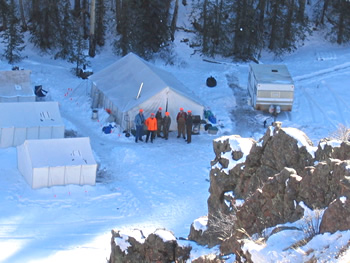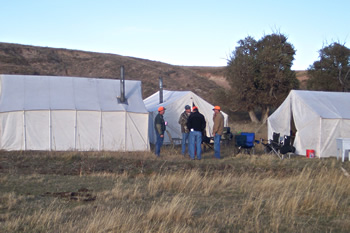 Think of your drop camp as a Do-It-Yourself hunt, with all your hard gear (tent, cooking utensils, pots, and pans, firewood) already up on the mountain. With a fully guided hunt you have someone to prepare meals and work with you to find your elk. I’d like to compare cost as flying first class (Fully guided hunt) vs. Business class (drop camp), never mind economy class (self guided with your own equipment). With a drop camp you will have camp set and you will be situated in elk country. You will save money by cooking your own meals, and discovering your area hunting at your own pace, I’ll expand on this a little later. Hopefully this article will help you prepare for your drop-camp hunt. Late May is the perfect time to interview outfitters who provide drop camp service for the area or areas that you submitted for in the draw in April. According to the Colorado Department of Regulatory Affairs, there are some 830 active outfitters in Colorado, though not all are hunting-related. Your job is to whittle down the list to the one that's right for you.
Think of your drop camp as a Do-It-Yourself hunt, with all your hard gear (tent, cooking utensils, pots, and pans, firewood) already up on the mountain. With a fully guided hunt you have someone to prepare meals and work with you to find your elk. I’d like to compare cost as flying first class (Fully guided hunt) vs. Business class (drop camp), never mind economy class (self guided with your own equipment). With a drop camp you will have camp set and you will be situated in elk country. You will save money by cooking your own meals, and discovering your area hunting at your own pace, I’ll expand on this a little later. Hopefully this article will help you prepare for your drop-camp hunt. Late May is the perfect time to interview outfitters who provide drop camp service for the area or areas that you submitted for in the draw in April. According to the Colorado Department of Regulatory Affairs, there are some 830 active outfitters in Colorado, though not all are hunting-related. Your job is to whittle down the list to the one that's right for you.
Do Your Homework
Even if friends and family provide you with a referral, it's still a good idea to sit down and outline your goals and expectations for your hunt. The first step is to locate outfitters that work in the units you have applied for or know where you will be hunting. A great place to start is the Colorado Outfitters Association.
 Before you call or send a message to CPW or COA, it might be helpful to refer to the valuable information on Plan Your Hunt and note some of your expectations. For example, you may want to get back five miles off the road into a high alpine basin with streams and pocket meadows while toting no more than 50 pounds in your pack.
Before you call or send a message to CPW or COA, it might be helpful to refer to the valuable information on Plan Your Hunt and note some of your expectations. For example, you may want to get back five miles off the road into a high alpine basin with streams and pocket meadows while toting no more than 50 pounds in your pack.
Once your homework is done, check your expectations against reality. If you sit at an office all day, are you going to be able to ride on horseback for any length of time? If the terrain is higher than you're conditioned for, can you make the climbs, walk the ridges and pack out your animal after the harvest. Your hunt may turn out a bit more strenuous than you wanted and your dream hunt may turn into a nightmare.
Talk To The Outfitter
Prepare a list of questions for your target outfitters and check their license status. How long have they been guiding in the area? Find out a little about their hunting experience. Calling references is a must. Try to get contact information both successful and unsuccessful clients. Remember, even the most experienced guide and all the planning in the world won't guarantee a successful hunt. Many guides will share stories with you about the person that missed the perfect 10-yard broadside shot, or the archer that didn't consider wind as they approached an elk. Unless you're hunting behind a fence, a guaranteed harvest should be a big caution sign for you.
Check the fine print. It's important to review the contract and cancellation policy carefully, along with Deposit requirements and final payment due dates. Find out how often the guide will be checking on you in camp, whether you can expect fresh provisions and whether there will be cell phones or two-way radios so you can call for pick-up.
Find out what kind of camp kit will be provided: Will you have a wall tent? Will firewood be provided? What kind of cook stove? Fuel? Matches? Cups, spoons and bowls? A cot? Sleeping bag? Toilet paper? (No detail is too small). Be sure to ask how the guide wants you to leave camp. Breaking down camp, be sure to arrange how the guide wants you to leave the camp in your absence, the best rule of thumb is if you pack it in, pack it out. Be prepared to bring a pack with some emergency medical supplies and survival items. Most hunters do this anyway but do not just assume the drop camp will have such supplies.
Getting Down To Business
 When an outfitter sets up a drop camp, you should expect that he has learned through experience to put you in an area that holds elk. Even if you don't have time to scout, prior to your departure you should try to become as familiar as possible about where you will be hunting. Get maps, look at satellite photos, talk to the outfitter after you have looked at the maps to be able to discuss specific points on the map. The CPW Hunting Atlas offers new interactive maps with good information for the backcountry hunter. It allows users to view big game concentrations and game management units on top of USGS topographic maps or high resolution color aerial photography. A good outfitter will show you locations where you have the best chance to see and hear elk, but it's called "hunting" for a reason. Be sure you have at least one good map and a GPS unit. To help increase your odds, take plenty of notes. The guide has no control over what might show up in the area you are hunting, including other hunters, but he may lay out some choices for you in case you get company.
When an outfitter sets up a drop camp, you should expect that he has learned through experience to put you in an area that holds elk. Even if you don't have time to scout, prior to your departure you should try to become as familiar as possible about where you will be hunting. Get maps, look at satellite photos, talk to the outfitter after you have looked at the maps to be able to discuss specific points on the map. The CPW Hunting Atlas offers new interactive maps with good information for the backcountry hunter. It allows users to view big game concentrations and game management units on top of USGS topographic maps or high resolution color aerial photography. A good outfitter will show you locations where you have the best chance to see and hear elk, but it's called "hunting" for a reason. Be sure you have at least one good map and a GPS unit. To help increase your odds, take plenty of notes. The guide has no control over what might show up in the area you are hunting, including other hunters, but he may lay out some choices for you in case you get company.
On one hunt we were camped in a wilderness area and woke up to the sweet sound of cows mewing and bulls bugling. We followed the herd into a gigantic basin just in time to watch a pair of hunters drop in and blow every elk out of the valley. The elk ran past us, but we were unable to take a clean shot and never saw the herd again.
Another thing to settle ahead of time is what you'll need to do if you get an elk down. Will your guide expect you to quarter or bone your elk and bring the meat to camp? Or will your guide head out and pick up your animal where it lays? What gear or supplies will the guide have at camp? Ropes and pulleys? Tarps, saws and game bags? Be sure to know what you will need to carry in case you do harvest. (For a primer on field-dressing your animal, check out the DVD "From the Field to Table". If you're hunting with a group, make sure you know before the hunt what the plan is after the first elk is down. Cold storage for the elk while you're still out helping others should be pre arranged.
Finally, before you make a single payment do some final checks on the outfitter to assure the set up is legal. Go to the Department of Regulatory Agencies (DORA) site's Office of Outfitters Registration and do a name search and see if the guiding license is active. Also while at the Dora site check out their newsletter where you will find outfitters that have encountered some Disciplinary Actions, and complaints. The final measure should come from your communications with the guide and feedback from the referrals. Sometimes personalities don't match and if you have a hard time communicating with the potential guide, look somewhere else.
If you have paid attention to details and everything checks out well, you will know the drop camp guide you hired is the right choice for you.
Good luck, and have a safe hunt.

